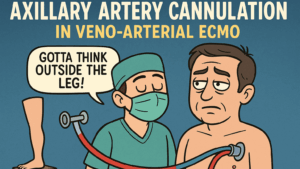This case report details the treatment of a 59-year-old male patient who developed retrograde type A aortic dissection (AAAD) six years after undergoing thoracic endovascular aortic repair (TEVAR). TEVAR, a well-established method for various aortic pathologies, carries potential complications such as vascular injury, embolism, and new entry tears. Retrograde type A aortic dissection is one such serious complication that demands immediate surgical intervention.
The patient, with a history of TEVAR for type B acute aortic dissection, presented with altered mental status. Magnetic resonance imaging (MRI) revealed cerebral infarction, and computed tomography (CT) scans showed AAAD extending to the arch vessels, with the true lumen of the right common carotid artery (RCCA) not opacified. The patient underwent total arch replacement with right carotid artery bypass to address these issues.
During surgery, an intimal tear was found near the TEVAR site. Cardiopulmonary bypass with hypothermia and circulatory arrest was used. A branched graft was anastomosed to the arch, reconstructing the left common carotid artery (LCCA) and innominate artery. Direct ultrasonography revealed no antegrade flow in the RCCA, leading to the decision to perform an arch graft-carotid artery bypass for restoring antegrade flow.
The operation involved a complex sequence of procedures, including establishing cardiopulmonary bypass through the left femoral artery, inducing hypothermia, and performing circulatory arrest. The duration of cardiopulmonary bypass, circulatory arrest, and antegrade cerebral perfusion were 333, 75, and 113 minutes, respectively. Postoperatively, the patient showed some mobility reduction in the left upper extremity and had frontal lobe dysfunction, indicated by attention deficits and a decline in organizational abilities. These symptoms gradually improved, and he was eventually transferred to a rehabilitation facility. Follow-up after one year showed the patient was stable with no neurological complications.
The case highlights the complexity and risks associated with TEVAR and the subsequent management of its complications, particularly retrograde type A aortic dissection. While TEVAR offers advantages such as reduced morbidity and shorter recovery compared to open surgical repair, its complications can be life-threatening. Retrograde type A aortic dissection, although rare, is a significant complication, with an incidence of 2.5% and a high mortality rate. Factors like proximal bare stent, aortic wall vulnerability, and aortic diameter may contribute to the onset of AAAD after TEVAR.
Cerebral malperfusion (CM) is a critical complication associated with AAAD, as seen in this case. The approach to securing antegrade cerebral blood flow through carotid artery bypass, as done for the patient, demonstrates a vital therapeutic strategy in such scenarios. This case underscores the importance of careful long-term monitoring and management of patients who have undergone TEVAR, given the potential for delayed but severe complications such as retrograde type A aortic dissection and cerebral malperfusion.







